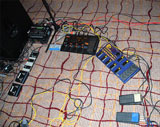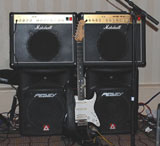
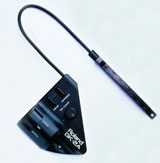
Roland GK-2A MIDI Guitar converter fitted to an acoustic or electric guitar
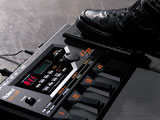
Roland GR-33 Guitar Synthesizer used for stage

Roland GR-50 Guitar Synthesizer used in the studio
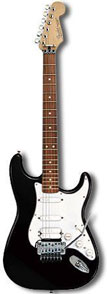
Fender Strat Ultra fitted with a Roland GK-2A hex pickup
More pictures of my MIDI guitar rig
Click for pictures for
larger images
What is a MIDI guitar?
MIDI guitar is an instrument (in my case equipment attached to an instrument) that allows access to synthesized sounds - strings, brass, flutes, acoustic guitars and even drums and special effects, by playing the guitar strings. This is very exciting and provides limitless possibilities. (It can also make your keyboard player extremely 'cheesed' off!)
You can layer different sounds to each of the guitar's six strings and also layer several sounds to an individual string so you might have a huge orchestra of 36 different instruments - assigning 6 instruments to each string. You can change to exotic guitar tunings simply by calling up a patch on the guitar synth.
I play an American Fender Stratocaster Ultra (4 lace sensor pickups) with a Roland GK-2A pickup attached (and YES there IS room to attach the GK2A in front of the bridge despite the double pickups at the bridge position - see picture below) into a Roland GR33 Guitar synthesizer on stage or a Roland GR50 in the studio. The GR50 may be a little out dated particularly in the sounds it makes but it is a formidable piece of kit as is the GR33.
 |
The Roland GK-2a piuckup is fitted to the Strat between the back bridge pickup and the bridge itself
On stage, I MIDI out from this to a Digitech VHM5 Vocal Harmonizer and MIDI thru' to a Roland SC55 Sound Canvas. The SC55 provides some respectable synth sounds which are layered with the internal sounds of the GR-33, but the VHM5 gives me the ability to play a chord on the MIDI guitar and sing up to 5 part harmoney on my own - the harmonizer tracking the chords I play.
As I use the rig live, I have to use 2 sets of on stage amplifiers - one for the guitar and guitar sounds and one for the synth. There are 3 output jacks on the GR-33. One is mono guitar out and the other two are Stereo L & R synth outs. Each of the three outputs eventually get routed to either of two volume foot pedalswhich enable me to mix the guitar vs synth sound in real time. Everything is in stereo.
 |
MIDI Guitar Rig configuration - click for a larger image
The GK2A guitar converter can be mounted on electric or acoustic guitars. All string sensitivity adjustments are done from the GR- 33 or GR-50, and the GK2A has footswitches or up/down buttons for patch selection and other control functions
Midi guitar is a very different type of guitar to play even though you are actually playing an ordinary guitar. You have almost certainly heard of - if not encountered the ubiquitous 'MIDI Delay'! This is a delay or hesitation which is experienced when playing a string and hearing the sound. This can be caused by two main reasons.
The first is the synth sound that you are using. If it has a slow 'attack' like a swelling string sound then obviously if you play 32 notes to the bar at 160bpm, you are not giving the sound envelope time to reach its full maximum before you cut the note off and start the next. Therefore it appears that several notes are missing from what you play. Well the answer to this is don't use a sound with a slow attack if you are playing Van Halen. Select a sound from your arsenal that has a quick attack like a flute or brassy sound.
The other reason for an apparent delay is the time the (Roland) synthesizer takes to read the note you have played on the guitar. Because high notes (top strings) have a fast wave cycle and low notes (bottom strings) have a very slow wave cycle it takes lower notes longer to make one and a half sine waves - which is what the synth requires to understand which note you've played. If this really bugs you and you can't live with it, then substitute your bottom strings o your guitar (E and A) with thin top strings (B and E) tuned to E and A but two octave up. The reading cycle is faster and to get the note in the correct octave, just detune that midi channel part by 2 octaves below!

MIDI Guitar -
a serious problem solved!
When I first took up MIDI guitar one of the biggest headaches was an awful audiable buzz or hum.
This was caused by the fact that the guitar was connected to its own amplifier and the guitar synth was connected to a second amp.
Some 'experts' suggested that I cut the earth off the guitar synth. I never did for safety reasons and neither should you!
It took quite a while to come across the answer after I tried special leads with resistors in and plugging the mains plugs into isolated sockets.
The answer was found in using a cheap Behringer DI box
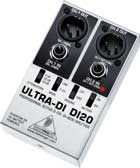
From what I understand, the signal is transferred via an induction coil within the box which effectively eliminates all hum and buzz. I now use DI boxes to connect the whole rig up to the main PA as well which eliminates all of my hum and buzz problems.
Visit my band-page
on the Quartz website for more information
 |
Core
| Profile
| Live Music
| Recording
| Video Animation Image | Web Design
| Education
| Links | Misc | Contact
© d y s o n g s 2009
© d y s o n g s 2009
